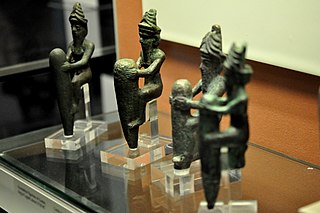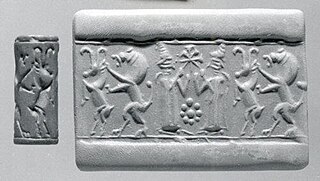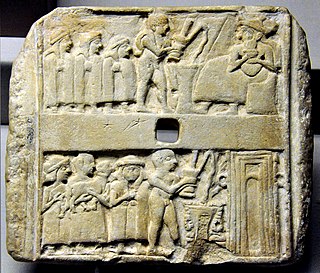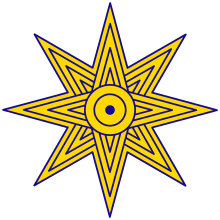
Gilgamesh was a hero in ancient Mesopotamian mythology and the protagonist of the Epic of Gilgamesh, an epic poem written in Akkadian during the late 2nd millennium BC. He was possibly a historical king of the Sumerian city-state of Uruk, who was posthumously deified. His rule probably would have taken place sometime in the beginning of the Early Dynastic Period, c. 2900 – 2350 BC, though he became a major figure in Sumerian legend during the Third Dynasty of Ur.

Inanna is the ancient Mesopotamian goddess of love, war, and fertility. She is also associated with sensuality, procreation, divine law, and political power. Originally worshiped in Sumer, she was known by the Akkadian Empire, Babylonians, and Assyrians as Ishtar. Her primary title was "the Queen of Heaven".

Shamash was the ancient Mesopotamian sun god, earlier known as Utu. He was believed to see everything that happened in the world every day, and was therefore responsible for justice and protection of travelers. As a divine judge, he could be associated with the underworld. Additionally, he could serve as the god of divination, typically alongside the weather god Adad. While he was universally regarded as one of the primary gods, he was particularly venerated in Sippar and Larsa.The moon god Nanna (Sin) and his wife Ningal were regarded as his parents, while his twin sister was Inanna (Ishtar). Occasionally other goddesses, such as Manzat and Pinikir, could be regarded as his sisters too. The dawn goddess Aya (Sherida) was his wife, and multiple texts describe their daily reunions taking place on a mountain where the sun was believed to set. Among their children were Kittum, the personification of truth, dream deities such as Mamu, as well as the god Ishum. Utu's name could be used to write the names of many foreign solar deities logographically. The connection between him and the Hurrian solar god Shimige is particularly well attested, and the latter could be associated with Aya as well.

The Anunnaki are a group of deities of the ancient Sumerians, Akkadians, Assyrians and Babylonians. In the earliest Sumerian writings about them, which come from the Post-Akkadian period, the Anunnaki are deities in the pantheon, descendants of An and Ki, the god of the heavens and the goddess of earth, and their primary function was to decree the fates of humanity. They should not be confused with the Apkallu.

The Burney Relief is a Mesopotamian terracotta plaque in high relief of the Isin-Larsa period or Old-Babylonian period, depicting a winged, nude, goddess-like figure with bird's talons, flanked by owls, and perched upon two lions.

In geometry, an octagram is an eight-angled star polygon.

The Mole People is a 1956 American science fiction adventure horror film distributed by Universal International, which was produced by William Alland, directed by Virgil W. Vogel, and stars John Agar, Hugh Beaumont, and Cynthia Patrick. The story is written by László Görög. The film was released on December 1, 1956, on a double feature with their jungle adventure film Curucu, Beast of the Amazon. It has also been featured on episodes of Mystery Science Theater 3000 and Svengoolie.

The Emblem of Iraq since the rule of Baathism features a golden black eagle looking towards the viewer's left dexter. The eagle is the Eagle of Saladin associated with 20th-century pan-Arabism, bearing a shield of the Iraqi flag, and holding a scroll below with the Arabic words جمهورية العراق.

Nanaya was a Mesopotamian goddess of love closely associated with Inanna.

A rosette is a round, stylized flower design.

Dingir ⟨𒀭⟩, usually transliterated DIĜIR, is a Sumerian word for 'god' or 'goddess'. Its cuneiform sign is most commonly employed as the determinative for religious names and related concepts, in which case it is not pronounced and is conventionally transliterated as a superscript ⟨d⟩, e.g. dInanna.
Queen of Heaven was a title given to a number of ancient sky goddesses worshipped throughout the ancient Mediterranean and the ancient Near East. Goddesses known to have been referred to by the title include Inanna, Anat, Isis, Nut, Astarte, and possibly Asherah. In Greco-Roman times, Hera and Juno bore this title. Forms and content of worship varied.

Anu or Anum, originally An, was the divine personification of the sky, king of the gods, and ancestor of many of the deities in ancient Mesopotamian religion. He was regarded as a source of both divine and human kingship, and opens the enumerations of deities in many Mesopotamian texts. At the same time, his role was largely passive, and he was not commonly worshipped. It is sometimes proposed that the Eanna temple located in Uruk originally belonged to him, rather than Inanna, but while he is well attested as one of its divine inhabitants, there is no evidence that the main deity of the temple ever changed, and Inanna was already associated with it in the earliest sources. After it declined, a new theological system developed in the same city under Seleucid rule, resulting in Anu being redefined as an active deity. As a result he was actively worshipped by inhabitants of the city in the final centuries of the history of ancient Mesopotamia.

Sumerian religion was the religion practiced by the people of Sumer, the first literate civilization found in recorded history and based in ancient Mesopotamia. The Sumerians regarded their divinities as responsible for all matters pertaining to the natural and social orders.

In ancient Mesopotamian mythology, the Bull of Heaven is a mythical beast fought by the hero Gilgamesh. The story of the Bull of Heaven is known from two different versions: one recorded in an earlier Sumerian poem and a later episode in the Standard Babylonian Epic of Gilgamesh. In the Sumerian poem, the Bull is sent to attack Gilgamesh by the goddess Inanna for reasons that are unclear.

The ancient Mesopotamian underworld, most often known in Sumerian as Kur, Irkalla, Kukku, Arali, or Kigal and in Akkadian as Erṣetu, although it had many names in both languages, was a dark, dreary cavern located deep below the ground, where inhabitants were believed to continue "a transpositional version of life on earth". The only food or drink was dry dust, but family members of the deceased would pour sacred mineral libations from the earth for them to drink. In the Sumerian underworld, it was initially believed that there was no final judgement of the deceased and the dead were neither punished nor rewarded for their deeds in life.

Venus, as one of the brightest objects in the sky, has been known since prehistoric times and has been a major fixture in human culture for as long as records have existed. As such, it has a prominent position in human culture, religion, and myth. It has been made sacred to gods of many cultures, and has been a prime inspiration for writers and poets as the morning star and evening star.
Manzat (Manzât), also spelled Mazzi'at, Manzi'at and Mazzêt, sometimes known by the Sumerian name Tiranna (dTIR.AN.NA) was a Mesopotamian and Elamite goddess representing the rainbow. She was also believed to be responsible for the prosperity of cities.

Arjan bowl is a bronze bowl dated between 800 B.C and 500 B.C. It was discovered in 1982 after a bulldozer working on the Marun Dam project cut into a rock tomb near Behbahan, Iran.

Annunitum or Anunītu was a Mesopotamian goddess of war. While initially she functioned as an epithet of Ishtar, she started to develop into a separate deity in the final years of the Sargonic period and through the Ur III period.




















